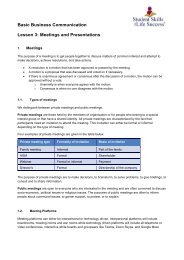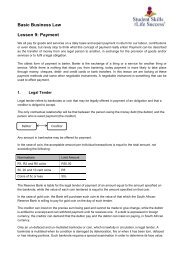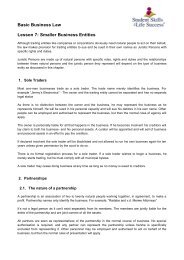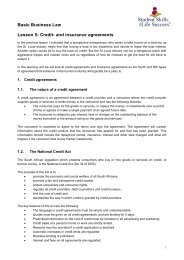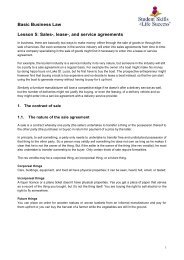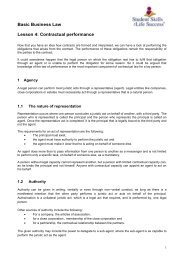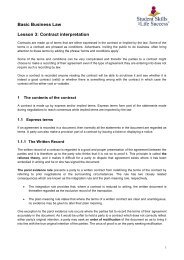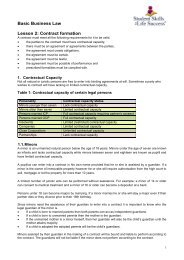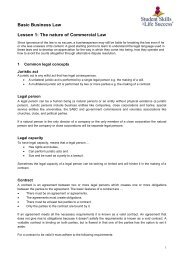Basic Business Law. Lesson 8. Companies
This is the eighth lesson of the "Student Skills for Life Success" "Basic Business Law" course. The topics covered in this booklet are: 1. The nature of a company 2. The Companies Act 3. The Companies and Intellectual Property Commission 4. Types of companies 5. Forming a company 6. Trading as a private company 7. Shareholder meetings 8. Duties and rights of directors 9. Private companies in financial distress
This is the eighth lesson of the "Student Skills for Life Success" "Basic Business Law" course. The topics covered in this booklet are:
1. The nature of a company
2. The Companies Act
3. The Companies and Intellectual Property Commission
4. Types of companies
5. Forming a company
6. Trading as a private company
7. Shareholder meetings
8. Duties and rights of directors
9. Private companies in financial distress
You also want an ePaper? Increase the reach of your titles
YUMPU automatically turns print PDFs into web optimized ePapers that Google loves.
• comply with laws and regulations,<br />
• define levels of materiality (see example <strong>8.</strong>3)),<br />
• delegate certain powers to management and reserve other powers to itself,<br />
• have access to company information and records,<br />
• agree a procedure to allow directors to obtain independent professional advice<br />
• decide on the number of directors required to make the Board effective,<br />
• identify and monitor key risk and key performance areas,<br />
• identify and monitor non-financial aspects, like the company’s impact on the environment,<br />
• record facts and assumptions which lead it to conclude that the business will be a going concern<br />
in the next financial year and state what steps are taken if not,<br />
• explain the effect of all proposed resolutions to be passed at shareholders meetings,<br />
• encourage shareowners to attend general meetings,<br />
• ensure the Chairperson of the Audit and Remuneration Committees and as many directors as<br />
possible attend shareholders meetings,<br />
• provide CV's of all directors who are to be appointed,<br />
• have a board charter setting out its responsibilities and<br />
• determine a balance between governance constraints and entrepreneurial performance.<br />
Example<br />
The board must draft statements that say which amounts, transactions, or discrepancies are significant<br />
enough to require further explanation.<br />
For example, it is normal for any company to have bad debts, and once these are indicated they would<br />
normally require no further explanation. But if most of the bad debt can be attributed to a single transaction<br />
and the amount is above the threshold amount that was indicated in the materiality statement, then the<br />
directors will have to explain what happened to the shareholders.<br />
9. Private companies in financial distress<br />
If the directors of a company have reasonable grounds to believe that the company is in financial distress,<br />
they must either …<br />
• place the company under <strong>Business</strong> Rescue or<br />
• liquidate the company or<br />
• send a notice to all shareholders, creditors, employees and trade unions that the company is in<br />
financial problems and give reasons why the company is not liquidated or placed under<br />
<strong>Business</strong> Rescue.<br />
9.1. <strong>Business</strong> Rescue<br />
<strong>Business</strong> rescue is largely a self-administered regime by the company, in consultation with all the<br />
stakeholders. For example, the employees might agree to accept lower salaries for a time or the creditors<br />
can agree to wait for payment in an attempt to save the business. It is however independently supervised<br />
and is subject to court intervention at any time on application by any of the stakeholders.<br />
The stakeholders which are recognised and allowed to participate in the development and approval of a<br />
<strong>Business</strong> Rescue (BR) plan include the shareholders, creditors and employees of the company.<br />
The interests of employees and workers are protected by the following measures:<br />
• They are recognised as creditors of the company with a voting interest.







